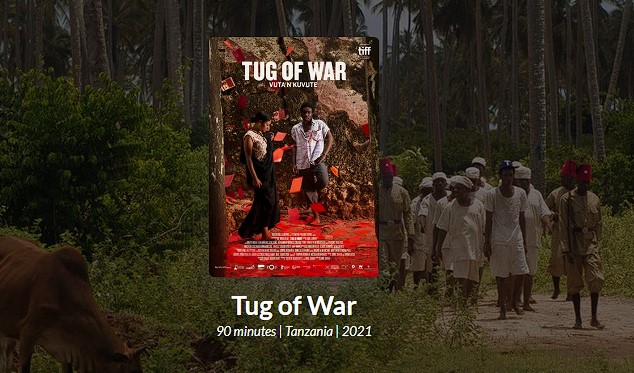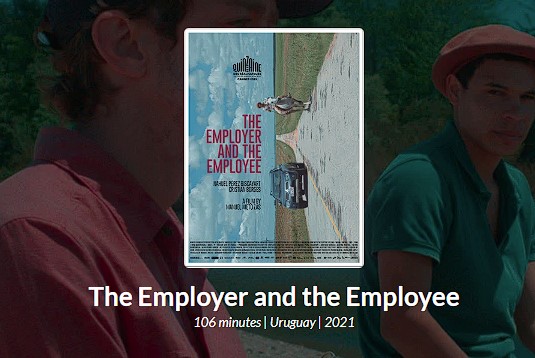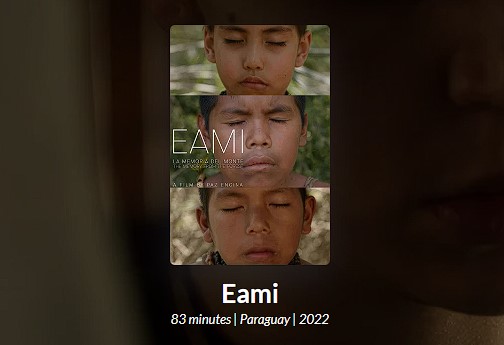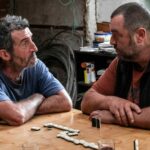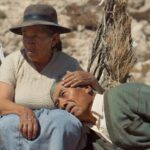………A few African countries have had their independence story told, but mainly those where the situation is less complex than in the East African country of Tanzania. The film is set in 1954, before independence arrived there in the early 1960s and when Tanzania was divided into two separate regions: Tanganyika (mainland Africa, with its capital of Dar es Salaam) and Zanzibar (the coast and archipelago), both under separate British colonial rule. Tug of War is set in the archipelago region, which had been dominated by an Arab Sultanate in the 19th century when it was the center of the East Africa slave trade, with over 50% of the population being slaves and, hence, the many references to slavery in the film.
……..Arabic is still the dominant language in the region today, but, as the film emphasizes, Zanzibar is highly multicultural, with different ethnicities involved in the push for self-determination against colonial rule. The film reflects this multicultural reality by having an Indian woman, Yasmin, who has run away from an arranged marriage to an Arab, join forces with an African revolutionary (Russian-trained Denge). Director Amil Shivji’s second feature shifts from his focus on more contemporary local problems of corruption and marginalized communities to an examination of the roots of his country’s current situation. Interestingly, the film plays down the usual dramatics of a political thriller and foregrounds the evolving relationship of Yasmin and Denge.
……….The pace of the film is slow but absorbing and the cinematography is moody, employing slow motion, rich shadows and languorous close-ups, especially highlighting the transformation of Yasmin from subjugated wife to confident freedom fighter.
Shivji’s subdued approach is a testament to Tanzania’s current success as one of the most stable of African countries, countering the stereotypical notion of Africa as a failed experiment in self-determnation.
……..Family viewing movies featuring children are a staple throughout the world and tend to be formulaic, featuring stories that are generic and without much depth. However, when these films come from less familiar places, the cultural differences on display can add new life to oft-repeated plot elements. Such is the case with Sujit Bidari’s first feature, the Nepal situated Butterfly on the Windowpane, which focuses on the frustrated lives of Chaupadi Indian children in a poor rural village in Nepal.
……The film offers us the usual incidents of school mishaps, misunderstandings by parents, sibling rivalry and neighbourhood bullies, but these children’s film staples are complicated by both poverty and rigid cultural traditions. Thirteen year old Bidya’s desire for education and poetry is hamstrung by her emerging sexuality and the typical fate of young Indian girls: an arranged marriage. Her younger brother, Basanta faces a similar sobering fate: exile to the streets of Kathmandu, with the promise of prosperity but the likelihood of a hardscrabble life on the streets.
In addition, the children’s alcoholic father is a further impediment to their healthy development.
“The Employer and the Employee”
Review by John Le Blanc
San Sebastian International Festival 2021
2021 Nominee Horizons Award for best Film
.……..A number of South American films, such as Argentinian director Lucretia Martel’s La Cienaga and The Headless Woman, explore the region’s prevalent exploitation of the working class by the upper middle class.
……..Manolo Nieto Zas’s third feature, The Employer and the Employee takes a more complex approach, as the agricultural landowners are not merely decadent but having understandable difficulties running their farm business. Neither are they overly aloof from their workers, as the farm’s patriarch and, especially, his son, Rodrigo exhibit respect towards their employees. The film pays particular attention to the similarities between the two groups: both Rodrigo and Carlos (the inexperienced working class young man Rodrigo hires) have young families. Rodrigo himself lacks experience managing the farm. He also exhibits immaturity in his use of marihuana while Carlos is obsessed with racing horses, a pursuit well beyond his lowly situation.
………. When tragedy strikes, the two sides of Uruguay’s social spectrum move toward each other, but the barriers between the classes are not so easily removed.
……… So, while the film effectively reveals the common humanity between its two protagonists, Rodrigo and Carlos, it also retains their differences, mirroring the large imbalance between modern life and traditional ways tied to the land that characterizes present-day Uruguay. In subtly revealing this problematic reality, the film employs some unique metaphors particularly that of the two white horses: one associated with Carlos early in the film and the other, a highly prized thoroughbred belonging to Rodrigo’s father, which becomes the focus of the film’s climax.
Alongside its poetic leanings, the film offers a realistic portrayal of an unglamorous rural Uruguayan life, understating the conflicts in order to have us think more deeply instead of merely engaging our emotions.
EAMI
Review by john Le Blanc
Rotterdam International Film Festival
2022 Winner Tiger Award
Paz Encina (director)
…….EAMI takes us inside the expansive consciousness of the Ayoreo – Totobiegosode indigenous people of the remote, semi-arid Chaco region of western Paraguay. These people are being driven from the forest that is central to their identity (EAMI means forest/world) by the extreme deforestation practices of colonizers (conones), interestingly represented here by a white woman depicted as performing household chores inside, in contrast to indigenous life situated outside.
……..In the film, the indigenous people are represented by a young girl, named Eami, and we experience the feelings of grief she endures as she becomes separated from her land and people. Eami’s experience is framed within a creation story, placing the disaster that has befallen her and her people in the context of how their world began and evolved.
……..Eami herself is identified with the bird deity Asoja (whose wings have been clipped by the deforestation disaster), illustrating the film’s notion that these people live with no boundaries between gods, humans and animals nor between life and death or past, present and future as Eami moves freely among all these levels.
……..Paz Encina’s third feature, all set in her native Paraguay and dealing with social justice issues, eschews linear plot development and instead offers a series of poetic impressions, featuring monologues and testimonies and some documentary footage and photos, but no dialogue. Sound also plays a key role in the depiction, with the noise of barking dogs associated with the colonizers and the sound of the forest accompanying the end credits.

